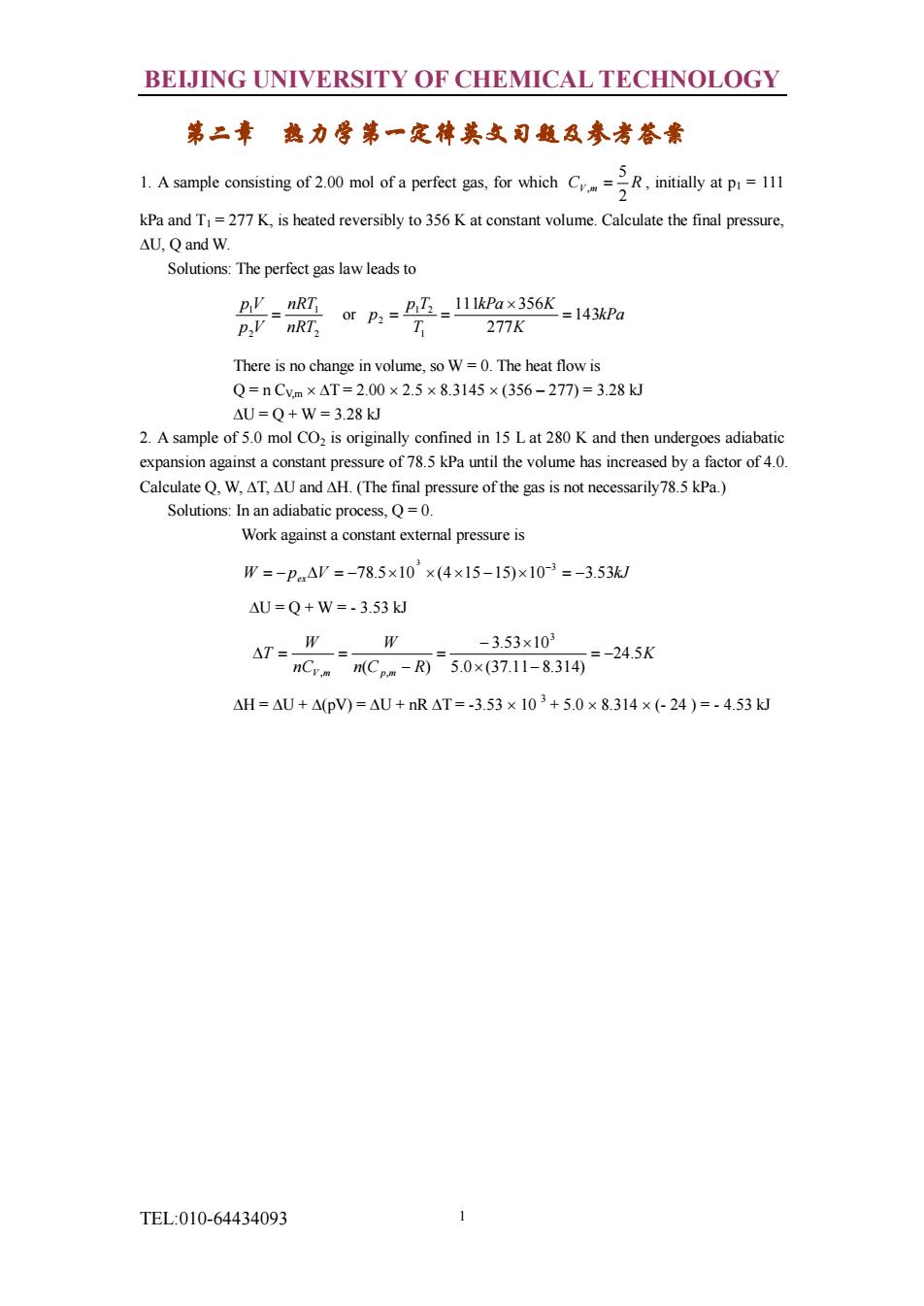
BEIJING UNIVERSITY OF CHEMICAL TECHNOLOGY 第二章热力学第一定律英文司题及参考答素 1.Asample consisting of 2.00 mol of a perfect gas,for which CR,initially at111 kPa and T1=277K,is heated reversibly to 356 K at constant volume.Calculate the final pressure, △U,Q and W Solutions:The perfect gas law leads to T or p:11kPax356KP P,VnRT, T 277K There is no change in volume,so W=0.The heat flow is Q=nCvm×△T=2.00×2.5×8.3145×(356-277)=3.28kJ △U=Q+W=3.28kJ 2.A sample of 5.0 mol CO2 is originally confined in 15 L at 280 K and then undergoes adiabatic expansion against a constant pressure of 78.5 kPa until the volume has increased by a factor of 4.0. Calculate Q,W,AT,AU and AH.(The final pressure of the gas is not necessarily78.5 kPa.) Solutions:In an adiabatic process,Q=0. Work against a constant external pressure is W=-p△V=-78.5×10×(4×15-15)×10-3=-3.53kJ △U=Q+W=-3.53kJ AT=m -3.53×103 nC。mCnm-R50xg7.11-8314-245K △H=△U+△(pV)=△U+nR△T=-3.53×103+5.0×8.314×(-24)=-4.53kJ TEL:010-64434093
BEIJING UNIVERSITY OF CHEMICAL TECHNOLOGY TEL:010-64434093 1 第二章 热力学第一定律英文习题及参考答案 1. A sample consisting of 2.00 mol of a perfect gas, for which CV m R 2 5 , = , initially at p1 = 111 kPa and T1 = 277 K, is heated reversibly to 356 K at constant volume. Calculate the final pressure, DU, Q and W. Solutions: The perfect gas law leads to 2 1 2 1 nRT nRT p V p V = or kPa K kPa K T p T p 143 277 111 356 1 1 2 2 = ´ = = There is no change in volume, so W = 0. The heat flow is Q = n CV,m ´ DT = 2.00 ´ 2.5 ´ 8.3145 ´ (356 – 277) = 3.28 kJ DU = Q + W = 3.28 kJ 2. A sample of 5.0 mol CO2 is originally confined in 15 L at 280 K and then undergoes adiabatic expansion against a constant pressure of 78.5 kPa until the volume has increased by a factor of 4.0. Calculate Q, W, DT, DU and DH. (The final pressure of the gas is not necessarily78.5 kPa.) Solutions: In an adiabatic process, Q = 0. Work against a constant external pressure is W p V kJ ex 78.5 10 (4 15 15) 10 3.53 3 3 = - D = - ´ ´ ´ - ´ = - - DU = Q + W = - 3.53 kJ K n C R W nC W T V m p m 24.5 5.0 (37.11 8.314) 3.53 10 ( ) 3 , , = - ´ - - ´ = - D = = DH = DU + D(pV) = DU + nR DT = -3.53 ´ 10 3 + 5.0 ´ 8.314 ´ (- 24 ) = - 4.53 kJ